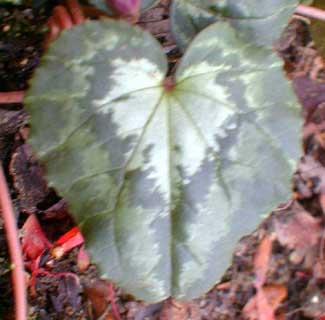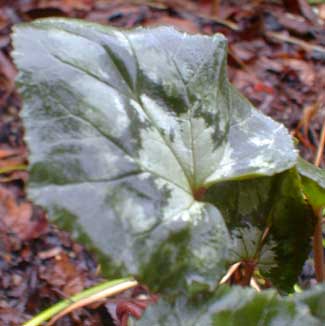
Silverheart
Shell Pink Autumn Cyclamen
"He looks like the color
Of my song
A bit sad -- cyclamen
However -- however
It's him that I love."
-Celine Dion,
b. 1968
b. 1968
This "Silverheart" form of Cyclamen hederifolium hederifolium has a double-shield, the center shield being a deeply silvered heart, surrounded by a green, followed by a zone of pewter with rays extending to the finely serrated leaf edges.
Its flowers are pale pink & appear ahead of the leaves in September, lasting until November or so. The gorgeous leaves are in place from October until early spring.
It's care & habits are the same as already covered on several other pages about sundry forms of C. hederifolium, so I want presently to provide a meditation on the cyclamen of ancient mythology.
The Greek epigramist Dioscorides (fl. 200 B.C.E.) was declared in the Garland of Meleager (fl. 100 B.C.E.) to be "the cyclamen of the Muses." Hesiod in his Theogony associated ''wild, almost leafless cyclamen, pale dots of purple" with Mount Helicon in Boeotia, where of course they grew, but they grew on every mountain. Helicon was however most important to the Muses, for thereon the they were worshipped by poets & philosophers & maiden colleges.
I've long wanted to find a written use for a funny word I invented, & will do so here: Hesiod describes the Muses, nine in number, thuslywise:
"On Helicon's peak they join hands in lovely dancesTheir feet pound because they are violent maeanads tramping up & down the hillsides in honor of the Great Mother, & from their pounding treads flowers arose. They awaken desire because their behavior enhances fertility, fertility of the land & its people, & of the arts & imagination.
and their pounding feet awaken desire."
A cyclamen of the Muses was not only the flower, but it was some aspect of themselves; the blooms rising out of soil, even in dry infertile places, was like the Muses themselves in little clusters of dancing beauties. It was that aspect of themselves that dwelt within poets, singers, & playwrights.
 Virgil (70-19 B.C.E) in his Eclogues recommends that poets entwine cyclamen blossoms around their heads as protection from the "wicked tongue" of whomsoever would bring harm to bards. This protection is conferred by the Earthmother whose first gifts for childhood are "ivy ranging everywhere with cyclamen."
Virgil (70-19 B.C.E) in his Eclogues recommends that poets entwine cyclamen blossoms around their heads as protection from the "wicked tongue" of whomsoever would bring harm to bards. This protection is conferred by the Earthmother whose first gifts for childhood are "ivy ranging everywhere with cyclamen."Cyclamens as a protective charm arranged around the forehead, perhaps attached to a wreath of ivy, takes us back to Meleager's Garland which is likened to a garland of flowers worn as a headband.
This association of cyclamens with the Mother Goddess goes at the very least as far back as the aesthetic flower-religion of Minoan Crete. Flowers often represented the cycles of the seasons, & symbolized the life & death & birth cycle of humanity. A great many flowers were associated with sacrificial myths wherein a king or god or the Great Mother's male fertility daemon is seasonally slain, flowers or grain erupting wherever his blood spills, like semen, upon the Earth: the hyacinth from the death of Hyacinthos, the daffodil from Narcissus, the anemone from Adonis; millet from Baal Hadad; possibly even the Easter Lily from Jesus.
Something of this association survives in Catholic mythology when the cyclamen is associated with the Virgin Mary much as it was, in ancient times, with Cybele. And the red "nose" of the pale pink flowers represent Mary's suffering heart when her son was tortured & slain.
Continue to
Cyclamen hederifollium 'Green Elf'